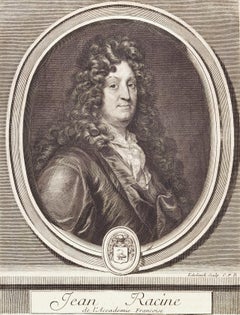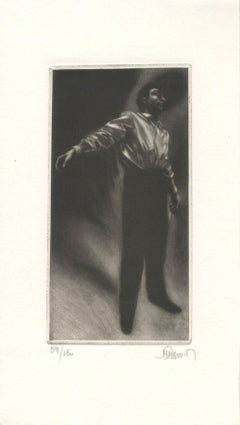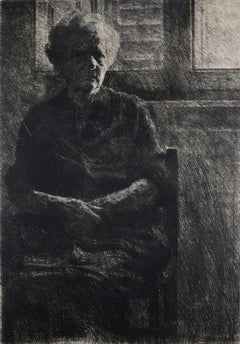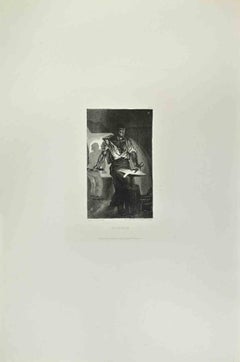Photography Portrait Prints
to
164
307
131
138
93
64
Overall Width
to
Overall Height
to
166
154
72
45
37
22
15
9
5
3
2
2
27
24
10
10
8
28
159
314
234
14
5
12
14
7
6
53
49
26
42
22
586
95
48
6,439
3,528
3,035
2,614
1,859
1,519
1,211
1,106
910
774
735
440
388
385
249
211
199
195
176
174
194
189
142
78
70
183
309
370
239
Art Subject: Photography
Jean Racine Portrait: 17th C. Engraving by Edelinck in Perrault's Les Hommes
Located in Alamo, CA
This is a 17th century portrait engraving of Jean-Baptiste Racine by Gerard Edelinck (1640-1707), published in Charles Perrault's 'Les Hommes Illustres' in Paris in 1696. Jean Racine (1639-1699) was a French dramatist, one of the three great playwrights of 17th-century France, along with Molière and Corneille. Racine's works were primarily tragedies. He wrote Phèdre, Andromaque, and Athalie. He did write one comedy, Les Plaideurs, and a muted tragedy, Esther for young readers. His writing is renowned for its elegance, purity, speed, and fury. The American poet Robert Lowell described his style as a "diamond-edge" and the "glory of its hard, electric rage". Racine's works often displayed his psychological insight, the passion of his characters, and the stark reality of his plots and stage descriptions. In 1672, he was elected to the Académie Française, and two years later he achieved the title of "treasurer of France", and later the honorary title of an "ordinary gentleman of the king" to King Louis XIV, and subsequently a secretary of the king .
This beautiful engraved portrait is printed on chain-linked, laid paper with wide margins. The sheet measures 17.13" high by 10.75" wide. There is a small spot in the lower margin and a few tiny faint spots in the margins, but the print is otherwise in very good condition. The original descriptive text pages, 81 & 82, are included.
Provenance: This engraving was owned by Arthur Pomeroy, 1st Baron Harberton and the Viscount Harberton (1723-1798). He was an Irish politician, who represented County Kildare in the Irish House...
Category
Late 17th Century Old Masters Portrait Prints
Materials
Engraving
Man with Outstretched Arms
Located in New Orleans, LA
Maurice Pasternak has created a portrait of his signature figure with outstretched arms. He moves images around on the paper to create a sense of mystery and drama. This impression ...
Category
Late 20th Century Surrealist Portrait Prints
Materials
Mezzotint
$131 Sale Price
25% Off
White Blouse (~43% OFF LIST PRICE, Portrait, Hip-length, Long-haired girl)
Located in Kansas City, MO
Robert Brawley
White Blouse
Year: 1991
Lithograph
Edition: 45
Paper: Arches Cover, White
Paper Size: 34 x 25 inches
Image Size: 28.5 x 21 inches
Signed and numbered by hand
COA provi...
Category
1990s Modern Portrait Prints
Materials
Lithograph
$1,666 Sale Price
42% Off
El Dandy - James Sparshatt - BW portrait photograph of cigar smoking Cuban man
Located in Coltishall, GB
Location: Havana
Series : Spirit of the Revolution
Year: 2001
Portrait of Elvirio el Dandy. An icon of Old Havana at the turn of the century. His custom of wearing finery has spaw...
Category
21st Century and Contemporary Naturalistic Black and White Photography
Materials
Silver Gelatin
My Great Mum (the artist's mother, a quintessential Italian matriarch)
Located in New Orleans, LA
"My Great Mum" is a loving portrait of the artist's Italian mother.
Paolo Ciampini was born in Montopoli in Val d'Arno in 1941. After graduating from the Art Institute of Cascina (...
Category
1990s Portrait Prints
Materials
Etching
Un Forgeron - Etching by Eugène Delacroix - 1870s
Located in Roma, IT
Un Forgeron is an artwork realized by Eugène Delacroix in the 1870s.
Etching.
Good conditions.
Realized for the "Société des Aquafortistes. Born on the initiative of the publisher...
Category
1870s Modern Figurative Prints
Materials
Etching
Girl from Washington Square. Limited edition print, Established Polish artist
Located in Warsaw, PL
Vibrant giclee limited edition print by worldwidely established Polish artist Rafal Olbinski. Figurative surrealistic print with girl sitting on a chair with model of Washington Squa...
Category
2010s Surrealist Figurative Prints
Materials
Paper, Color
Portrait of Niccolò Machiavelli - Lithograph by Dolfino - 19th Century
Located in Roma, IT
Portrait of Niccolò Machiavelli is an original artwork realized by Dolfino in the 19th Century.
Lithograph
Good condition.
Category
19th Century Modern Figurative Prints
Materials
Lithograph
Films of Andy Warhol, Whitney Museum framed poster (Hand Signed by Billy Name)
By Billy Name
Located in New York, NY
Billy Name
Films of Andy Warhol, Whitney Museum of American Art (Hand Signed by Billy Name), 1988
Offset Lithograph
Very rare vintage poster - hand signed by Billy Name on the front.
Frame Included
Very rare vintage poster - when hand signed by Warhol...
Category
1980s Pop Art Portrait Prints
Materials
Lithograph, Offset, Permanent Marker
Cher, (Song) 1974/2004
Located in Greenwich, CT
Cher is a silver gelatin print created in 2004 from a 1974 negative. An example of this photographic portrait is owned by the Smithsonian for their National Portrait Gallery who hold...
Category
21st Century and Contemporary Contemporary Photography
Materials
Paper, Silver Gelatin
One of Twelve X (etchings of one of 12 heads based on monumental sculpture)
Located in New Orleans, LA
"One of Twelve X" is an etching, 1995, 4 3/4 x 4 3/4, edition: 24, signed in pencil. The print has an embossed chop in the lower right corner, a capital P in a circle indicating tha...
Category
1990s Post-Modern Portrait Prints
Materials
Etching
Billy Bengston (Portrait of the Pop Artist)
By Theo Wujcik
Located in Wilton Manors, FL
Theo Wujcik (1936-2014): Billy Al Bengston, 1970. Etching in black on wove paper. Unsigned.
9 x 8 in. (sheet), 10 x 9 in. (frame).
Custom welded brass frame with resolved corners a...
Category
1970s Photorealist Portrait Prints
Materials
Etching
$760 Sale Price
20% Off
Marie Laurencin Original Etching with Hand Coloring - Woman with Pearl Necklace
Located in Phoenix, AZ
Dark haired beauty with pearl necklace - original etching with
hand coloring by French artist Marie Laurencin (1885-1956).
Edition size: 40 of 80.
Stamped signature lower right. ...
Category
Mid-20th Century Portrait Prints
Materials
Paper, Ink
Pair of Oriental Figures - Woodcut after Katsushika Hokusai - late 19th Century
Located in Roma, IT
Oriental figures is an original modern artwork realized after Katsushika Hokusai in the late 19th Century.
Black and white woodcut print.
Includes a gilded frame.
Category
Late 19th Century Modern Figurative Prints
Materials
Woodcut
Greta Garbo, Pop Art Portrait by Rupert Jasen Smith
Located in Long Island City, NY
Artist: Rupert Jasen Smith, American (1953 - 1989)
Title: Greta Garbo
Year: 1988
Medium: Screenprint, signed and numbered in pencil
Edition: AP 12/15
Size: 43 x 34 in. (109.22 x 86.3...
Category
1980s Pop Art Portrait Prints
Materials
Screen
Beauté du XVIIIe Siècle 1
By Agent X
Located in Kansas City, MO
Agent X
Beauté du XVIIIe Siècle 1
Archival Pigment Inks on Canvas
Year: 2022
Size: 74x58in
Unique
Signed, dated by hand
COA provided
Ref.: 924802-1160
------------------------------...
Category
2010s Baroque Prints and Multiples
Materials
Digital, Cotton Canvas
$5,900 Sale Price
34% Off
Portrait No. 11
By Leonor Fini
Located in Columbia, MO
Leonor Fini (Argentine-French, 1907–1996)
A fiercely spirited Surrealist unfettered by social mores, Leonor Fini defied convention with her haunting, dreamlike works that explore the...
Category
20th Century Surrealist Portrait Prints
Materials
Paper, Lithograph
Lorna Simpson - Recall - 1998 Serigraph - HAND SIGNED
Located in Brooklyn, NY
Paper Size: 30 x 22 inches ( 76.2 x 55.88 cm )
Image Size: 13 x 22 inches ( 33.02 x 55.88 cm )
Framed: No
Condition: A: Mint
Additional Details: Hand signed, dated, labeled PP (Prin...
Category
1990s Contemporary Portrait Prints
Materials
Screen
$10,000 Sale Price
20% Off
El Dandy - Palladium platinum print
Located in Coltishall, GB
Portrait of Elvirio el Dandy. An icon of Old Havana at the turn of the century. His custom of wearing finery has spawned a whole generation of young “Dandies” who hang out on Havan...
Category
21st Century and Contemporary Naturalistic Black and White Photography
Materials
Platinum, Black and White
Tartar Family Katschcntzes - Lithograph by Auguste Wahlen - 1844
Located in Roma, IT
Tartar Family Katschcntzes is a lithograph made by Auguste Wahlen in 1844.
Hand colored.
Good condition.
At the center of the artwork is the original title "Famille Tartare Katsch...
Category
1840s Modern Figurative Prints
Materials
Lithograph
$184 Sale Price
35% Off
The Portrait - Woodcut by Robert Davaux - Early 20th Century
Located in Roma, IT
The Portrait is a print realized by Robert Davaux, in the early 20th century.
Signed on the plate, on the lower left margin.
Woodcut on paper.
Good conditions.
Category
Early 20th Century Modern Figurative Prints
Materials
Woodcut
Marilyn Monroe Winter Coat, Pop Art Offset Print by Sid Maurer
By Sid Maurer
Located in Long Island City, NY
Sid Maurer, American (1926 - ) - Marilyn Monroe Winter Coat, Medium: Offset Reproduction on Paper, signed in pen, Image Size: 16.5 x 12 inches, Size: 22 x 17 in. (55.88 x 43.18 cm)
Category
21st Century and Contemporary Pop Art Portrait Prints
Materials
Offset
Vintage Chinese Victory Cigarettes Advertisement Poster
Located in Chicago, IL
This 1930s advertisement for Victory Cigarettes melds the meticulous detail of traditional Chinese painting with the craft of color lithography—and a side of risqué. Posters like this one, influenced by the Art Deco movement in the West, recall the economic boom of early 20th century Shanghai, an international center of business and trade. Today, lithograph tobacco posters...
Category
Early 20th Century Art Deco Figurative Prints
Materials
Paper, Ink
Saba - XXI Century Contemporary Linocut Print Surrealism, Black & white
Located in Warsaw, PL
Anna Gawlikowska is a Polish artist born in 1980.
She studied printmaking, painting, and graphic design at the Academy of Fine Arts of Wroclaw in Poland in the workshops of professor...
Category
21st Century and Contemporary Contemporary Portrait Prints
Materials
Linocut, Paper
"Man of The Ouanergui Carrying the Tabbane" from "Costumes of Morocco"
Located in Detroit, MI
"Homme de L'Ouanergui Portant le Tabban" translated to "Man of The Ouanergui Carrying the Tabbane" is plate number 25 in Jean Besancenot's stunning por...
Category
1940s Portrait Prints
Materials
Paper, Gouache
Portrait of a Gentlewoman - Colored and Mezzotint - 18th Century
Located in Roma, IT
Portrait of a Gentlewoman is an original print on paper realized by Anonymous English artist in the late 18th Century.
The artwork represents a portrait of an elegant woman.
Mixed ...
Category
Early 1800s Figurative Prints
Materials
Etching, Mezzotint
$415 Sale Price
35% Off
Nancy outside in july XIV (Wrestling with Spirits) - Original handsigned etching
By Jim Dine
Located in Paris, IDF
Jim DINE (1935)
Nancy outside in july XIV (Wrestling with Spirits), 1981
Original etching with aquatint (Crommelynck workshop)
Signed in pencil
Numbered 19 / 30
On BFK Rives vellum ...
Category
1980s American Modern Portrait Prints
Materials
Etching, Aquatint
"Aiutante di Camera con la Mazza" - Etching by Giuseppe Capparoni - 1828
Located in Roma, IT
"Aiutante di Camera con la Mazza" is an Artwork realized in 1828 by the Engraver, Giuseppe Capparoni (Rome 1800- 1879).
Etching hand colored on ivory paper. Signed on plate and date...
Category
1820s Modern Portrait Prints
Materials
Etching
Fluor Funny Portrait. Between Blooms and Beings - Limited Edition
Located in FISTERRA, ES
"The Point of View" is a limited edition, high-quality Dibond direct UV print, part of the Fetiches series by Natasha Lelenco. Known for her meticulous portraiture, Lelenco brings a ...
Category
2010s Contemporary Portrait Prints
Materials
Metal
$170 Sale Price
20% Off
Firework. 1970, paper, silk screen printing, 85x61 cm
Located in Riga, LV
Firework. 1970, paper, silk screen printing, 85x61 cm
Josif Elgurt (1924-2007)
Born in 1924 in Kishinev in Romania. In 1947 resumed his art studies in Kishinev. Since 1952 he has l...
Category
1970s Realist Figurative Prints
Materials
Paper, Screen
$425 Sale Price
20% Off
L'Enfant Aux Cerises - Original Etching by H. Berengier after E. Manet - 1900
Located in Roma, IT
L'Enfant Aux Cerises is an original print in etching technique on ivory paper, realized after Edouard Manet (French Painter; 1832-1883) and by Henri Berengier, engraver and sculptor....
Category
1860s Figurative Prints
Materials
Etching
Portrait - Etching by Giacomo Porzano - 1972
Located in Roma, IT
Hand Signed. Edition of 90 pieces plus 15 pieces in Roman Numbers.
Excellent condition.
Category
1970s Contemporary Figurative Prints
Materials
Etching
Portrait No. 9
By Leonor Fini
Located in Columbia, MO
Leonor Fini (Argentine-French, 1907–1996)
A fiercely spirited Surrealist unfettered by social mores, Leonor Fini defied convention with her haunting, dreamlike works that explore the...
Category
20th Century Surrealist Portrait Prints
Materials
Lithograph, Paper
Portrait No. 12
By Leonor Fini
Located in Columbia, MO
Leonor Fini (Argentine-French, 1907–1996)
A fiercely spirited Surrealist unfettered by social mores, Leonor Fini defied convention with her haunting, dreamlike works that explore the...
Category
20th Century Surrealist Portrait Prints
Materials
Paper, Lithograph
Marilyn Monroe Posing in Studio, ca. 1950s, 18, 1 x 23, 9 cm
Located in Cologne, DE
Norma Jeane Mortenson or better known as Marilyn Monroe – iconic, beautiful and maybe the most known Hollywood Stars of the 20th century. Born and raised in Los Angeles, USA, she spe...
Category
1950s Modern Black and White Photography
Materials
Black and White
Old Man - Original Etching on Paper by Henri Piere Jamet - 19th Century
Located in Roma, IT
Old Man is an original etching artwork on paper realized by Henri Piere Jamet (1858-1921).
The state of preservation is very good and aged with small tearing on the margins.
Sheet ...
Category
20th Century Modern Figurative Prints
Materials
Paper, Etching
Alan Litho (Shaman)
Located in Columbia, MO
Benjamin Parks is a Kansas City based artist whose primary focus is painting large-scale portraits and figurative work, though he also produces illustrations, interactive installatio...
Category
21st Century and Contemporary Contemporary Figurative Paintings
Materials
Archival Paper, Lithograph, Monotype
Meta-Koosega Chippeway Warrior: Original Hand-colored McKenney & Hall Lithograph
Located in Alamo, CA
This is an original 19th century hand-colored McKenney and Hall lithograph of a Native American entitled "Meta-Koosega, Chippeway Warrior,...
Category
Mid-19th Century Naturalistic Portrait Prints
Materials
Engraving
Limited Ed. Etching of a Scholar, Possibly a Cleric, with a Book in Deep Thought
Located in Alamo, CA
This is a large framed limited edition etching depicting an older white haired bearded scholar, possibly a cleric, with a hat, sitting with a book, but deep in thought. It is eligibl...
Category
20th Century Other Art Style Portrait Prints
Materials
Etching
Willi Kissmer (1951-2018) - Framed Contemporary Etching, White Ribbons
Located in Corsham, GB
A limited edition etching in colours by contemporary artist Willi Kissmer (1951-2018). Signed in pencil to the lower margin. Editioned E.A (artist proof). Mounted in a sleek silver-e...
Category
21st Century and Contemporary Portrait Prints
Materials
Etching
Portrait No. 13
By Leonor Fini
Located in Columbia, MO
Leonor Fini (Argentine-French, 1907–1996)
A fiercely spirited Surrealist unfettered by social mores, Leonor Fini defied convention with her haunting, dreamlike works that explore the...
Category
20th Century Surrealist Portrait Prints
Materials
Paper, Lithograph
Portrait No. 4
By Leonor Fini
Located in Columbia, MO
Leonor Fini (Argentine-French, 1907–1996)
A fiercely spirited Surrealist unfettered by social mores, Leonor Fini defied convention with her haunting, dreamlike works that explore the...
Category
20th Century Surrealist Portrait Prints
Materials
Paper, Lithograph
The Physiognomy - Portrait - Original Etching by Thomas Holloway - 1810
Located in Roma, IT
The Physiognomy - Portrait is an original etching artwork realized by Thomas Holloway for Johann Caspar Lavater's "Essays on Physiognomy, Designed to Promote the Knowledge and the Lo...
Category
1810s Modern Figurative Prints
Materials
Etching
The Physiognomy - Etching by Thomas Holloway - 1810
Located in Roma, IT
The Physiognomy - The Portrait is an original etching artwork realized by Thomas Holloway for Johann Caspar Lavater's "Essays on Physiognomy, Designed to Promote the Knowledge and th...
Category
1810s Old Masters Figurative Prints
Materials
Etching
Russell Young, Jimi Hendrix Mug Shot, acrylic screen on canvas
Located in Chatsworth, CA
This piece is an original acrylic screen print on canvas created by Russell Young in 2007. Russell Young is a British Pop artist known for his large-scale silkscreen paintings of cu...
Category
Early 2000s Pop Art Portrait Prints
Materials
Canvas
Lithuanian French Artist Arbit Blatas Lithograph Marc Chagall School of Paris
By Arbit Blatas
Located in Surfside, FL
Arbit Blatas (1908 – 1999)
Hand signed and numbered to lower edge
Ecole de Paris Portrait
Printed on Arches French deckle edged art paper
1962
Arbit Blatas (1908 – 1999), born Nicol...
Category
1960s Expressionist Figurative Prints
Materials
Lithograph
Ann Chernow, I Want to Report a Murder...My Own, 2018, silkscreen, oil, canvas
By Ann Chernow
Located in Darien, CT
Ann Chernow’s work is based on impressions related to images from movies from the l930s and l940s. She uses film clips, studio publicity material, fan magazines and other memorabilia...
Category
2010s Feminist Portrait Prints
Materials
Canvas, Oil, Pencil, Screen
Guy Levis-Mano, Modern Woodcut by Valentine Hugo
Located in Long Island City, NY
Valentine Hugo, French (1887 -1968) - Guy Levis-Mano, Year: 1975, Medium: Woodcut on laid paper, signed in the plate, Edition: 255, Image Size: 5 x 3 inches, Size: 10 x 7.5 in. ...
Category
1970s Modern Portrait Prints
Materials
Woodcut
Johannes Huibert Prins (1756-1806) - 1783 Etching, The Drinker
Located in Corsham, GB
This etching depicts a seated figure in a rustic interior, with meticulous cross-hatching creating depth and texture throughout the composition. The central subject is portrayed in a...
Category
18th Century Portrait Prints
Materials
Etching
Portrait - Etching by Frederique O’Connell - Mid-20th Century
Located in Roma, IT
Portrait is an etching realized by Frederique O’Connell in the 19th Century.
Good conditions with slight foxing.
The artwork is realized through deft expre...
Category
Mid-20th Century Modern Figurative Prints
Materials
Etching
Sam Shaw THE JOY OF MARILYN 1986 Exhibition Poster, Marilyn Monroe, Summer Dress
Located in Union City, NJ
THE JOY OF MARILYN is a fine art exhibition poster by the renowned American photographer and film producer, Sam Shaw produced in 1986 in conjunction with Sam Shaw's photography exhibition in New York City. THE JOY OF MARILYN was printed using color offset lithography techniques on white satin finish paper, fine quality poster, full color image, copyright text printed below image lower right. Print size - 34 3/8 x 22 inches, image size 22 3/8 x 17 inches, unframed, excellent condition, unsigned
Year published - 1986. THE JOY OF MARILYN photo...
Category
1980s Contemporary Portrait Prints
Materials
Offset
Portrait of Fletcher Harper - Lithograph by F. Halpin - 1885
Located in Roma, IT
Portrait of Fletcher Harper is a lithograph print on paper realized by F. Halpin in 1885.
Signed and Titled on the plate
Good conditions with slight foxing and folding.
Category
1880s Modern Figurative Prints
Materials
Lithograph
Farmers Wife, Modern Etching by Linda Plotkin
Located in Long Island City, NY
Linda Plotkin, American (1938 - ) - Farmers Wife, Year: circa 1965, Medium: Etching on BFK Rives, signed, titled and numbered in pencil, Edition: 6/40, Image Size: 12 x 14 inches...
Category
1960s Modern Portrait Prints
Materials
Etching
Portrait - Screen Print by Bettino Craxi - 1990s
Located in Roma, IT
Portrait is an original screen print realized by Bettino Craxi in 1992.
The artwork is from the portfolio "The World", Ed. Serigraph, 1992.
Signed and numbered in the bottom by the...
Category
1990s Contemporary Figurative Prints
Materials
Lithograph
Portrait de Jeune Fille Portrait of a Girl 1970 original aquatint Leonor Fini
By Leonor Fini
Located in Paonia, CO
Portrait de Jeune Fille is a haunting portrait of a young girl also known as .. Justine… she could be either fading into the distance or just materializing out of a dream state. Her hair and the air around her is in shades of pale blue and the background is the white of the paper. This is a limited edition ( 170/300) aquatint , signed in the plate. In good condition with a 1" repaired tear midway on the right border which will not show when framed.
Argentinian-born artist Leonor Fini (1907-1996) is considered one of the great female artists of the twentieth century. She moved to Paris in the early 1930’s where she spent most of her life and almost immediately formed friendships with Salvador Dali, Cartier- Bresson, Max Ernst and other intellectuals of the time. At twenty five she had her first one person show in Paris and was included in the 1936 pivotal exhibition at MOMA…Fantastic Art, Dada and Surrealism…..and that same year had an exhibition at a famous avant garde gallery in New York. Although Fini never considered herself a Surrealist she maintained close personal relationships with several members of the group. One can see how their ideology influenced her work but she remained firmly rooted in the tradition of Symbolism, Metaphysics and Italian and German Romanticism Her works can be found in most important collections of modern art around the world.
Fini was renowned as a portraitist and as a painter of erotic sexual tensions with a mysterious atmosphere. She was adamant about being independent and not belonging to any one group. She lived life on her own terms and is sometimes referred to as …..the female Dali. She was also involved with designing for fashion and creating elaborate sets for opera and theatre. As a feminist she was definitely ahead of the times. She produced the first erotic male nude...
Category
20th Century Symbolist Figurative Prints
Materials
Aquatint
Massena - Etching by A. Ethiou - 1837
Located in Roma, IT
Desaix is an Etching realized by A. Ethiou in 1837.
Good conditions.
The artwork is realized in a well-balanced composition. the artwork and belongs to the suite suite "AtlasBatt" ...
Category
1860s Modern Figurative Prints
Materials
Lithograph
Ann Chernow, Noir II, 2016, Rag Paper, Etching
By Ann Chernow
Located in Darien, CT
Ann Chernow’s work is based on impressions related to images from movies from the l930s and l940s. She uses film clips, studio publicity material, fan magazines and other memorabilia...
Category
2010s Feminist Portrait Prints
Materials
Rag Paper, Etching
Klévak (Hand-colored)
By Leonor Fini
Located in Columbia, MO
Leonor Fini was born in Argentina in 1907 but travelled and lived in Europe with her mother from a young age. By 1931, she was in Paris, in the full swing of the Surrealist movement....
Category
20th Century Surrealist Portrait Prints
Materials
Paper, Ink, Etching
Hush - Le Buste III - Silver Edition - Urban Graffiti Street Art
By HUSH
Located in Asheville, NC
Le Buste III - Silver Edition
Artists: HUSH
Year: 2020
Class: Art Print
Released: 11/19/20
Run: 75
Technique: Screen Print
Paper: 300gsm Somerset Satin...
Category
2010s Street Art Portrait Prints
Materials
Gold
Self-Portrait - Etching By Edouard Dufeu -1888
Located in Roma, IT
Self-Portrait is an etching realized by Edouard Dufeu (1840-1900).
Proof artist.
Signed and dated on the upper left corner.
Edouard Jacques Dufeu , bo...
Category
1880s Modern Figurative Prints
Materials
Etching




